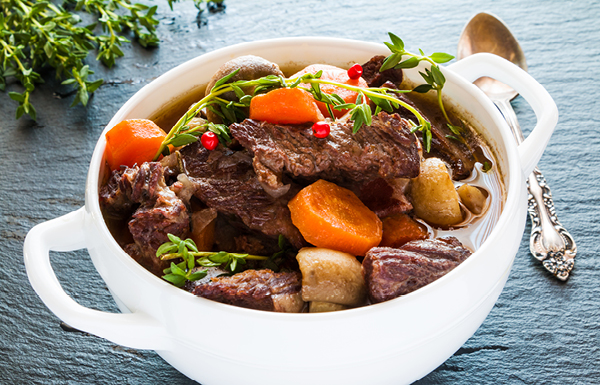Cooking with wine is simpler than you think.
If you’re a wine lover, you know there is a lot more to enjoying wine than just sipping. Wine can offer a wonderful enhancement to your cooking as well. Here are some tips from local restaurateurs along with a quick guide to selecting the right wine for cooking.
Wine in French Cooking
“We unapologetically serve classic French, and the vast majority of our recipes have wine in them. And all of our sauces use wine—sherry wine, still wine or brandy. That’s the French cuisine tradition,” said Chef Jacques Haeringer of L’Auberge Chez Francois.
“There’s not a huge distinction these days between American and French cuisine; much American cooking evolved from one of the European cuisine. In most of Europe wine was used in cooking and traditionally served with dinner. My dad [who founded the Great Falls restaurant] had a recipe book he brought with him from France.”
Chef Jacques’ tips: “If you’re using a still wine, as for a beef stew, brown the beef and vegetables and then put the red wine in, just until it boils. Then add the beef stock. Still wines tend to sour if you don’t give them a boil first. If you’re using fortified wines or brandy, you can add them at the end as a finishing wine, not unlike a drizzle of olive oil.”
“People used cooking wine, but nobody wants to drink that. I don’t recommend using the finest wines either; you should use something that is quite drinkable,” he continued. “Open a bottle, put a cupful into the recipe, and drink the rest! But most importantly, have fun. So much is overthought and overintellectualized.”
“Also, think about the locality of your dish, and think local. What wines are produced in that region? If it’s an Alsatian dish, a Pinot Noir or Riesling is a good choice, for example. For beef stew, like a Beef Bourguignon, use a burgundy wine. For fish, the choice is often a chardonnay.”
To learn more about cooking with wine, Chef Jacques holds cooking classes several times each month and maintains a list of YouTube videos featuring his PBS cooking show, Two for Tonight. Find the newly-released latest edition of the series’ companion cookbook, along with other cookbooks, DVDs and delicious treats on the L’Auberge Chez Francois website.
“…Still wines tend to sour if you don’t give them a boil first. If you’re using fortified wines or brandy, you can add them at the end as a finishing wine, not unlike a drizzle of olive oil.”
Wine in Italian Cooking
At Zeffirelli Ristorante Italiano, the wines most often used in their recipes are, naturally, Italian—primarily Pinot Grigio, Bordello, Prosecco, Champagne, and sweet and dry Marsala wines.
“For our rack of lamb we use a heavier wine, like a red; for fish, a white wine sauce; and for veal, a Pinot Grigio. We also sometimes use a Pinot Grigio for stronger fish dishes like snapper or blackfish,” explained José Argueta, general manager. “Cooking with wine is an art, try it a couple of times to get it right.”
“We generally recommend using about an ounce-and-a-half to three ounces of wine in a meal for two. Then serve the same wine to drink that you cooked with. But don’t make the mistake of not tasting the wine first,” he added.
Many of Zeffirelli’s dishes are accompanied by tasty sauces. “When we cook a sauce, we put, for example, the mushrooms, olive oil, salt and pepper into the pan. Once everything is hot, we add the wine. You have to boil it a little while to give it the flavor; if you don’t, you taste the wine but not the sauce. Add the sauce at the last minute to the dish you are serving.”
There are many characteristics to consider when choosing a cooking wine.
Flavors
Wine can offer a subtle or strong flavoring, depending on your intended result. Look at the tasting notes to see what naturally-occurring flavors are found in various wines. A red wine might taste of berries, cherries, plums, chocolate or coffee, while a white wine may offer flavors like melon, pineapple, citrus, floral or caramel.
Dryness
Wines range from dry to sweet, with the drier wines containing much less natural sugar.
Acids
Think of the acid as the tart or “bite” as in a lemon or vinegar. When you serve fish, you might serve them with lemon slices to bring out the natural flavors. Wine can also serve to bring forward more subtle flavors.
Tannins
Tannins refer to the bitterness of a wine; compare it to a strong cup of tea. Wines high in tannins pair well when cooking with foods with high protein, like steak or other hearty dishes.
Fortified Wines
Some of the best wines to cook with are Sherry, Port, Madeira and Marsala. Sherry offers a roasted nutty flavor that can enhance a soup, stew or sautéed dish, while the sweetness of Port can pair well with meat-based casseroles. Marsala adds a light fruitiness found in much of Mediterranean cooking, and Madeira adds caramel notes.
As a rule of thumb, pair light-colored foods like pork, chicken, turkey, seafood or fish with white wines and dark-colored foods like a stew, pasta, game meats, duck and beef with reds. Consider the use of the wine, too, and match the wine to its intended use. If a cream sauce is to be used with a steak, for example, use a white wine in the sauce to match the wine to the sauce, not the beef. You can still use the red wine as a marinade.
Avoid at all costs wines billed as “cooking wines.” They are cheap wines to which salt and coloring has been added.
Wine can be used as a substitute for fat, like butter, or oil by re-adding in the moisture. Use the wine plus a smaller amount of oil to sauté vegetables, for example. Or, since it is essentially an acid ingredient, use a wine-based marinade to tenderize foods. You can also cook foods in wine. Poach a fish in a saucepan with boiling wine, or add a few tablespoons of wine and bake the fish in a foil packet. Add wine to dishes you are simmering for added moisture and flavor. Reducing a wine through simmering accentuates it characteristics, whether they be tannic, acidic or sweet.
The biggest surprise is that wine can be used in baking, too. Use it as a partial substitute for some of the oil for a moist and tasty result.
Wine is so versatile it can be used in many creative ways to marinate, cook, or flavor a finished dish. When selecting your wine, determine the end result first. Then have fun experimenting. Soon you’ll be cooking with wine, too.
 Boeuf Bourguignon
Boeuf Bourguignon
Serves 10
For the marinade:
3 ½ to 4 pounds beef
3 cups strong red wine
1 cup sliced onions
1 cup coarsely sliced carrots
1 tablespoon red wine vinegar
¼ teaspoon freshly ground pepper
2 cloves
2 bay leaves
2 cloves garlic, peeled and crushed
pinch of thyme
For the bourguignon:
5 tablespoons oil
1 cup lardons (bacon sliced into sticks, ¼ inch thick x 1 inch long)
½ cup chopped onions
2 tablespoons flour
2 cups beef stock
2 to 3 cups marinade
¼ teaspoon pâté spices
sea salt
freshly ground pepper
To marinate the beef:
Cut the beef into 1-inch cubes and combine in a large bowl with all the marinade ingredients. Mix well, so that all pieces of meat are coated with the marinade. Cover and refrigerate overnight.
To prepare the bourguignon:
Remove the meat from the marinade and drain well in a colander. Strain the liquid into a small saucepan. Bring to a boil, skim thoroughly, and reserve for use in the bourguignon. Reserve the vegetables.
Preheat oven to 400 degrees.
Season the beef with salt and pepper. Heat 2 tablespoons of oil in a large skillet and sear half of the meat. Transfer the sautéed meat to a colander to drain. Add another 2 tablespoons of oil and brown the remaining meat on all sides and drain.
Heat the last tablespoon of oil in a large saucepan or a Dutch oven and sauté the lardons until lightly browned. Add the onions and cook until translucent, about 5 minutes.
Pour off the grease, add the meat to the Dutch oven, and place, uncovered, in the oven for 10 minutes, stirring once or twice.
Dust the meat with the flour and return to the oven for an additional 5 minutes. Mix the flour into the meat. Add the reserved vegetables and herbs from the marinade, the beef stock, and enough boiled marinade to completely cover the meat.
Cover the Dutch oven and set it in the oven. After 1 hour, reduce the heat to 325 degrees and continue cooking until the meat is easily pierced with a fork, approximately 2 more hours.
Remove the bourguignon from the oven and skim thoroughly. Finish the sauce with the pâté spices. Taste and adjust seasonings. Serve with spätzle.
Recipe from Chef Jacques Haeringer of L’Auberge Chez Francois.






